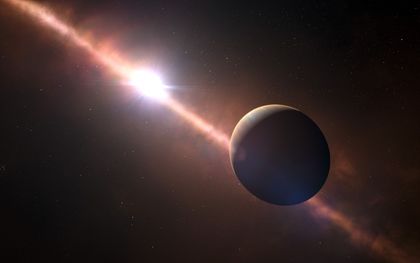Scientists have for the first time measured the rotation of a planet in another solar system — a juvenile, gassy giant spinning at a breakneck 90,000 kilometers per hour, they reported on Wednesday.
Orbiting a star about 63 light years from Earth, Beta Pictoris b is more than 16 times larger and 3,000 times more massive than our planet, but its days last only eight hours.
The findings are detailed in the latest issue of Nature. The journal reports:
“Exoplanets are typically hidden by the glare of their parent star and can only be discovered indirectly, but β Pictoris b was one of the first to be found by direct imaging. This was possible because the massive planet, at around 20 million years of age, is relatively young and still warm, so it radiates strongly at infrared wavelengths. In addition, the star system is only about 20 parsecs (65 light years) from Earth — the star β Pictoris, part of the constellation Pictor in the southern sky, is visible to the naked eye — and the planet orbits a long way away from the star, about twice Jupiter’s distance from the Sun.
“Those properties, as well as the composition of the star and the planet, enabled [Ignas] Snellen’s team to home in on the infrared light from β Pictoris b, using the Very Large Telescope in the Atacama Desert of northern Chile. ‘It’s exciting to see another kind of insight into the properties of extrasolar planets,’ says astronomer Thayne Currie of the University of Toronto.”
The Journal has a pretty detailed explanation of how they calculated the spin, so click through if you’re curious. The short of it is that they looked at how “the infrared light is filtered by carbon monoxide in its atmosphere.”
Earlier this year, scientists also discovered a cloud of poisonous gas in that solar system. They think the cloud is created by “ongoing rapid-fire collisions among a swarm of icy, comet-like bodies.”
Agencies/Canadajournal
 Canada Journal – News of the World Articles and videos to bring you the biggest Canadian news stories from across the country every day
Canada Journal – News of the World Articles and videos to bring you the biggest Canadian news stories from across the country every day



